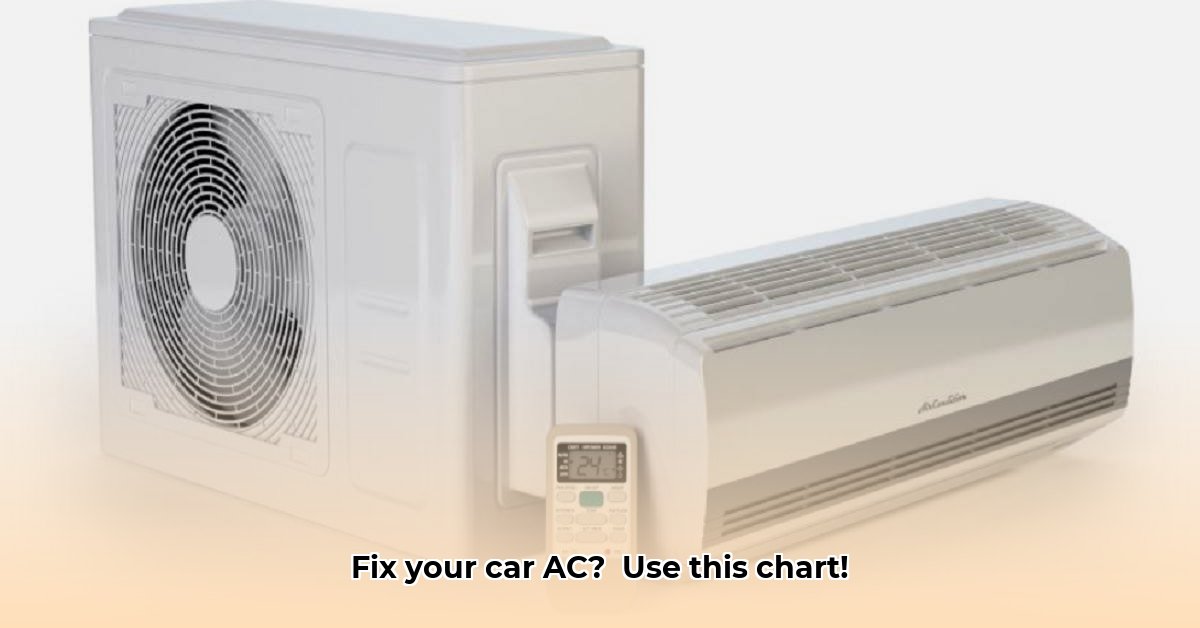Is your car’s AC system acting up, leaving you sweltering on a hot day? A simple pressure check, guided by an AC system pressure chart, can often help you pinpoint the problem. This instructional guide will explain refrigerant pressures and their significance in fixing AC issues. We’ll cover the essential differences between older (R-134a) and newer (R-1234yf) AC fluids and highlight crucial safety and legal considerations. For a handy reference chart, check out this AC pressure chart. Get ready to troubleshoot your AC and potentially save money!
AC System Pressure Chart: Decoding Your Car’s Air Conditioning
Experiencing unbearable heat in your car because of a malfunctioning AC system? Before spending money on a mechanic, you may be able to diagnose the issue with an AC system pressure chart. Think of it as your personal air conditioning detective kit. This guide will walk you through it, step-by-step, teaching you how to use a manifold gauge set, read static and dynamic pressure, and identify AC system problems. Accurate diagnosis can lead to a quicker and more affordable repair.
Understanding Your Car’s AC and Refrigerant Pressure
Your car’s air conditioning system uses a special coolant, known as refrigerant, to keep you cool by absorbing heat from the cabin. This refrigerant circulates through the system under pressure, and the pressure changes depending on the outside temperature and the refrigerant used (either R-134a or R-1234yf). The AC system pressure chart is your roadmap to understanding these pressure clues. It helps you interpret the readings from the low and high pressure sides of the system; significant differences from what the chart shows usually indicate a problem. Remember that releasing refrigerant into the air is illegal and harms the environment.
Using the AC System Pressure Chart: A Troubleshooting Guide
This section details a clear, step-by-step approach on how to use an AC system pressure chart for troubleshooting:
Step 1: Identify Your AC Refrigerant. Determine if your car uses R-134a or R-1234yf. Consult your owner’s manual, a sticker under the hood, or a qualified mechanic. Using the correct chart is critical, as different refrigerants exhibit different pressure characteristics.
Step 2: Check AC System Pressure. Use a manifold gauge set to measure the pressure on both the low and high pressure sides of the AC system. Connect the gauges to the appropriate service ports (low-side port and high-side port). Note the readings from both sides. Ensure that your gauge set is compatible with your system’s refrigerant type.
Step 3: Check Ambient Temperature. Note the outside, or ambient, temperature. Pressure readings on the chart vary in line with the temperature. Use an accurate thermometer for the most reliable readings.
Step 4: Read the AC Pressure Chart. Refer to the correct chart for your refrigerant type. At the intersection of your measured pressure readings and the ambient temperature, you will find the expected pressure range.
Here are example charts for both R-134a and R-1234yf refrigerants:
R-134a System Pressure
| Ambient (outside) Temperature °F | Standard Low Side Pressure Range PSI | Standard High Side Pressure Range PSI |
|---|---|---|
| 65 | 25-35 | 135-155 |
| 70 | 35-40 | 145-160 |
| 75 | 35-45 | 150-170 |
| 80 | 40-50 | 175-210 |
| 85 | 45-55 | 225-250 |
| 90 | 45-55 | 250-270 |
| 95 | 50-55 | 275-300 |
R-1234yf System Pressure
| Ambient (outside) Temperature °F | Standard Low Side Pressure Range PSI | Standard High Side Pressure Range PSI |
|---|---|---|
| 65 | 28-38 | 135-154 |
| 70 | 33-43 | 145-159 |
| 75 | 38-48 | 149-168 |
| 80 | 43-48 | 173-205 |
| 85 | 49-58 | 220-243 |
| 90 | 49-58 | 243-261 |
| 95 | 53-58 | 266-289 |
Step 5: Interpret the Results. If your pressure readings align with the “normal” range on the chart, your AC system is likely functioning correctly. Readings outside the normal range suggest a problem. Note these possible issues based on pressure readings:
- Low pressure on both sides: A leak may exist.
- High pressure on the high side, low pressure on the low side: Issues with the expansion valve or orifice tube may exist.
- High pressure on both sides: The system may be overcharged, or there could be a blockage.
- Low pressure on the high side, high pressure on the low side: Compressor issues may exist.
Common AC Problems and Diagnostic Tips
Here’s a quick look at some common problems and what your pressure readings might indicate. Remember, these are possibilities – not certainties. A proper diagnosis needs more investigation.
| Problem | Low-Side Pressure | High-Side Pressure | Other Clues |
|---|---|---|---|
| Refrigerant Leak | Low | Low | Weak cooling, hissing sound |
| Compressor Trouble | High | Low | No cooling, strange noises from compressor |
| Expansion Valve/Orifice Issue | Low | High | Weak cooling, ice buildup on evaporator |
| Condenser Issues | Normal to High | High | Weak cooling, condenser overheating |
| Overcharged System | High | High | Poor cooling, system strain |
Important Things to Keep in Mind When Using an AC Pressure Chart
While helpful, a pressure chart doesn’t provide the whole story. Electrical problems, fan issues, or blockages can also affect pressure readings, causing misinterpretations. The pressure chart is just a starting point. Be sure to check other system components.
R-134a vs. R-1234yf: Navigating Different Refrigerant Systems
These refrigerants are distinct. Always use the proper chart for the refrigerant in your vehicle. R-1234yf is more environmentally friendly but also mildly flammable. Using the wrong chart renders your readings useless. Never mix refrigerants.
Going Beyond the Pressure Chart
While a pressure chart is valuable, a proper diagnosis requires further investigation. Inspect for leaks, listen for unusual noises, and check electrical connections. If unsure, consult a qualified mechanic. They have specialized tools and knowledge to accurately diagnose and repair AC problems.
Remember, this guide provides a helpful starting point, but diagnosing and fixing car AC issues can be more complex than just reading a pressure chart. Always prioritize safety and seek professional help when necessary.
How to Accurately Interpret Automotive AC System Pressure Readings for R-134a and R-1234yf
Key Takeaways:
- Accurate pressure readings are crucial for diagnosing automotive AC system problems.
- Low-side pressure typically signals insufficient refrigerant, often caused by leaks.
- High-side pressure often points to overcharging or blockages within the system.
- Ambient temperature significantly influences pressure readings.
- R-134a and R-1234yf each require different pressure charts for correct interpretation.
- Refrigerant handling must adhere to safety and legal standards; venting is illegal and environmentally hazardous.
Understanding Your Automotive Air Conditioning System’s Pressure
Pressure is key to your car’s AC system. As with a water pump, it needs the correct pressure to function optimally; insufficient pressure leads to weak cooling, while excessive pressure can cause component failure. We’ll focus on accurately interpreting pressure readings for R-134a and R-1234yf, the two most common refrigerants. Understanding normal operating pressures is the first step in diagnosing any AC issue.
Using a Manifold Gauge Set for Automotive Systems
A manifold gauge set is essential for checking AC pressures. This tool measures both low-side and high-side pressures simultaneously. The low-side pressure reflects the refrigerant’s pressure before it enters the evaporator, and the high-side shows its pressure after it leaves the compressor and passes through the condenser. Proper connection of the gauge set to the service ports is critical for accurate readings.
Interpreting Pressure Readings: A Step-by-Step Guide
- Ambient Temperature Measurement: Accurate ambient temperature measurement is essential. Pressure readings vary with temperature. Use a reliable thermometer and consult a pressure chart specific to your refrigerant (R-134a or R-1234yf). These charts display ideal pressure ranges for different temperatures.
- AC System Status: Note the system’s status. Static (
- Plant Based Diet Breast Cancer: Research-Based Benefits - December 16, 2025
- Plant-Based Diet Ulcerative Colitis Remission: Proven Benefits - December 15, 2025
- Plant-Based Diet and Fibroids: Reduce Symptoms Now - December 13, 2025










